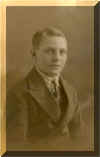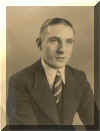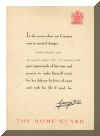
 These pictures are of Broxholme
House, the site of Harwood Road School.
The London County Council plaque can be seen on the corner of the building in
the second picture.
These pictures are of Broxholme
House, the site of Harwood Road School.
The London County Council plaque can be seen on the corner of the building in
the second picture.
As I discover them, from time to time I will add to this page a few things that are associated with my father.
My father attended Harwood Road School that was situate at the corner of Harwood and New Kings Road/Kings Road. The school was opened in 1873 but in 1928 the school was transferred to newly built premises called The Harwood School at Britannia Road, Fulham. The old school buildings were demolished in 1929 and the site was developed by the London County Council for a housing scheme, Broxholme House, that opened in 1931.

 These pictures are of Broxholme
House, the site of Harwood Road School.
The London County Council plaque can be seen on the corner of the building in
the second picture.
These pictures are of Broxholme
House, the site of Harwood Road School.
The London County Council plaque can be seen on the corner of the building in
the second picture.

 This is the entry in the
admissions register pertaining to my father. Entry number 1251 at the
top of the page shows that he was admitted on April 10th 1923 and
he left the school on March 27th 1929 due to age (meaning that he had attained
the age of fourteen). His address is
shown as 9 Avalon Road and his father is given as Claude a Coachbuilder.
It also states he had previously attended Harwood Road
Infants School.
This is the entry in the
admissions register pertaining to my father. Entry number 1251 at the
top of the page shows that he was admitted on April 10th 1923 and
he left the school on March 27th 1929 due to age (meaning that he had attained
the age of fourteen). His address is
shown as 9 Avalon Road and his father is given as Claude a Coachbuilder.
It also states he had previously attended Harwood Road
Infants School.
Acknowledgement: I am grateful for the extremely helpful and personal assistance given by the staff of the Archives & Local History Centre of Hammersmith & Fulham Council when I visited their offices at Talgarth Road.
Opposite the New Kings Road and Harwood Road junction (opposite the location of the school) is the small turning, Avalon Road. It used have entrances at both the New Kings Road and Ford Road but the entrance on the New Kings Road is now blocked by housing. Clearly now quite fashionable, No. 9 is pictured here. The house next door (Number 10) has a plaque that states:
 Alf Hill in 1929, aged
fourteen. He liked drawing and designing things. He seemed to have
a flair for this and whilst some of his drawings are obviously his
interpretations of photographs from magazines he was evidently quite skilled.
Alf Hill in 1929, aged
fourteen. He liked drawing and designing things. He seemed to have
a flair for this and whilst some of his drawings are obviously his
interpretations of photographs from magazines he was evidently quite skilled.
The Bargeman (titled Bargy) is dated September 1932 and I would guess that most of the rest are around this period, the girl with the dog being somewhat risqué for the time. George Arliss was a famous actor who would have been aged 64 in 1932 and the likeness here seems about right.
The statue drawing and the picture of the man examining the pipe are the most likely original concepts. The former is faintly signed and you can see the outline of an arch that he intended to draw around the subject. The latter has a sketch of a globe clearly intended for inclusion but unfinished. In this picture he has drawn object reflections on what he considered a shiny table surface but has not continued this for all objects. Neither has he drawn any refraction in the magnifying glass. Pretty good though!
 This is a very faint drawing of a car design. There's not much to it but
it does demonstrate a modern approach at the time.
This is a very faint drawing of a car design. There's not much to it but
it does demonstrate a modern approach at the time.
 Later he enhanced this
design and layered it on to the 20HP Armstrong Siddeley. This mainly pen
and ink drawing dates around 1934/5 and whilst the front of the car has
Armstrong Siddeley style the rear seems far more modern than the designs of
the time. To begin with, the rear boot lid is hinged at the top whereas
the then current style was to hinge at the base, often providing a
non-advertised "picnic table" feature. At this time he
was keen to get into the drawing office at Park Royal and it is my reasonable assumption
that this drawing along with the following two were work he did to demonstrate
his abilities.
Later he enhanced this
design and layered it on to the 20HP Armstrong Siddeley. This mainly pen
and ink drawing dates around 1934/5 and whilst the front of the car has
Armstrong Siddeley style the rear seems far more modern than the designs of
the time. To begin with, the rear boot lid is hinged at the top whereas
the then current style was to hinge at the base, often providing a
non-advertised "picnic table" feature. At this time he
was keen to get into the drawing office at Park Royal and it is my reasonable assumption
that this drawing along with the following two were work he did to demonstrate
his abilities.

 Dating late '34, these pen and
ink drawings were probably test pieces he did for his application to join the
Park Royal drawing office staff (I see no other reason whatsoever for him to
have done them). Whilst perhaps not the very best of draughtsmanship,
pen and ink is a much more difficult medium than pencil and to do this without
any mistakes takes considerable patience and care (my own experience vouches
for this). He was accepted into the drawing office by 1936.
Dating late '34, these pen and
ink drawings were probably test pieces he did for his application to join the
Park Royal drawing office staff (I see no other reason whatsoever for him to
have done them). Whilst perhaps not the very best of draughtsmanship,
pen and ink is a much more difficult medium than pencil and to do this without
any mistakes takes considerable patience and care (my own experience vouches
for this). He was accepted into the drawing office by 1936.
 Alf Hill in 1938, aged
twenty-three.
Alf Hill in 1938, aged
twenty-three.
 When Britain & France
declared war on Germany in 1939, newly married Alf was refused the "call-up" and
told to go back to Park Royal and design tanks and other armoured
vehicles. This he did but also between '43 & '44 he joined the
Homeguard. This is his certificate!
When Britain & France
declared war on Germany in 1939, newly married Alf was refused the "call-up" and
told to go back to Park Royal and design tanks and other armoured
vehicles. This he did but also between '43 & '44 he joined the
Homeguard. This is his certificate!